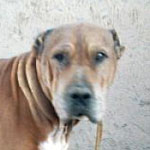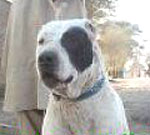Bully Kutta
 One of the most fascinating Molossers in history, this legendary eastern warrior is thought by some of its fanciers to had remained pure and unchanged since ancient times, while others question its true origin and background. Although there is some evidence that the Pakistani Bully Kutta was developed from the Sage Koochee, old Persian Alaunts, Afghani Gawi Bulldogs, Indian Mastiffs, Assyrian Mastiffs and dogs introduced by Alexander the Great, quite a few authorities believe it is a result of crossing local hunting dogs with Great Danes, German Pointers, English Mastiffs and Bulldogs, as well as other Western breeds brought to the region by the British soldiers in the 1700's. During the colonnial times, some English Bullterrier, White English Terrier and working British bandogge blood was indeed introduced to some strains of the Bully Kutta, but this was done primarily to create new breeds, such as the Gull Dong, the Gull Terr and the Bull Terr. These crossings were probably necessary for a number of reasons, including the need to improve the canine stock brought by the occupying forces, since their larger dogs, though capable combatants in their own right, simply weren't suited for the climate of the area, while the smaller ones were regularly being defeated by the native fighters. The differences between the true Bully Kutta and the "westernized" version of the breed were both physical and temperamental in nature, with the native animals being mostly white-coated and more primitive in features, as well as quite taller and overall sharper than their "improved" and more trainable counterparts, which were somewhat stockier, had shorter necks and a greater variety of coat colours, differing very little from some of the common bandogges found in the West.
One of the most fascinating Molossers in history, this legendary eastern warrior is thought by some of its fanciers to had remained pure and unchanged since ancient times, while others question its true origin and background. Although there is some evidence that the Pakistani Bully Kutta was developed from the Sage Koochee, old Persian Alaunts, Afghani Gawi Bulldogs, Indian Mastiffs, Assyrian Mastiffs and dogs introduced by Alexander the Great, quite a few authorities believe it is a result of crossing local hunting dogs with Great Danes, German Pointers, English Mastiffs and Bulldogs, as well as other Western breeds brought to the region by the British soldiers in the 1700's. During the colonnial times, some English Bullterrier, White English Terrier and working British bandogge blood was indeed introduced to some strains of the Bully Kutta, but this was done primarily to create new breeds, such as the Gull Dong, the Gull Terr and the Bull Terr. These crossings were probably necessary for a number of reasons, including the need to improve the canine stock brought by the occupying forces, since their larger dogs, though capable combatants in their own right, simply weren't suited for the climate of the area, while the smaller ones were regularly being defeated by the native fighters. The differences between the true Bully Kutta and the "westernized" version of the breed were both physical and temperamental in nature, with the native animals being mostly white-coated and more primitive in features, as well as quite taller and overall sharper than their "improved" and more trainable counterparts, which were somewhat stockier, had shorter necks and a greater variety of coat colours, differing very little from some of the common bandogges found in the West.

 Interbreeding between both of these types was common and while a small number of true Bully Kutta bloodlines have supposedly been preserved, much of the breed's gene pool has been corrupted, the effects of which are still felt to this day. Even the name of the breed is indicative of the influence foreigners had on the region, translating simply to "Bully Dog", lending some credence to the claims made by those who believe the Bully Kutta to be nothing more than a British-made Pakistani bandog with no ancient history whatsoever. The explanations offered by the breed fanciers for the apparent non-existence of the pre-colonnial name for the contoversial Pakistani Mastiff range from suggesting that the Bully Kutta is the continuation of the original Persian Alaunt to it actually being the same thing as the thought-to-be-extinct Gawii, but further research is required to establish whether these claims are valid or simple wishful thinking. Another theory points to the possibility of the Bully Kutta moniker being a corruption of "Boh'li Kutta" expression in Urdu language which is used to describe a heavily wrinkled dog.
Interbreeding between both of these types was common and while a small number of true Bully Kutta bloodlines have supposedly been preserved, much of the breed's gene pool has been corrupted, the effects of which are still felt to this day. Even the name of the breed is indicative of the influence foreigners had on the region, translating simply to "Bully Dog", lending some credence to the claims made by those who believe the Bully Kutta to be nothing more than a British-made Pakistani bandog with no ancient history whatsoever. The explanations offered by the breed fanciers for the apparent non-existence of the pre-colonnial name for the contoversial Pakistani Mastiff range from suggesting that the Bully Kutta is the continuation of the original Persian Alaunt to it actually being the same thing as the thought-to-be-extinct Gawii, but further research is required to establish whether these claims are valid or simple wishful thinking. Another theory points to the possibility of the Bully Kutta moniker being a corruption of "Boh'li Kutta" expression in Urdu language which is used to describe a heavily wrinkled dog.
 Regardless of the true ancestry of the breed, the Bully Kutta's popularity in its homeland remains reasonably strong, mostly due to much of the country's acceptance of dog-fighting tournaments as a way of life, although it should be noted that the practice of outcrossing hadn't been fully abandoned in some parts of Pakistan even after the British left the region, with many other breeds having been created using both the original Bully Kutta and its descendants over the years. Some of these newer Molossers are the Kohati Bulldogge, Nagi Bulldogge, Sargodha Bulldogge, Kanda Bulldogge and the Pakistani Boarhound. Nowadays, all of these breeds are being incorrectly classified as one and the same, especially in the West, where the Bully Kutta is slowly becoming popular. In recent years, these dogs have been assigned the misleading "South-Asian Mastiff" name, which conveniently does away with individual categorization of actual breeds and varieties found in the region, allowing the breeders of such animals to promote their stock in the West under a new exotic label, without having to worry about the actual ancestry of the dogs they import, breed and sell. While the best examples of pure Bully Kuttas are never sold to foreigners or even expatriates visiting Pakistan, inferiour dogs are readily available for export, with some breed authorities pointing out that the majority of Western-bred bloodlines aren't pure, having been crossed with various European dogs to soften the temperament and increase population. A number of dogs found in Europe are said to contain no Bully Kutta blood at all and are rumoured to be crosses between Great Danes and English Mastiffs, with the resulting offspring being superficially similar to the great Pakistani breed in terms of physical appearance and presented to unsuspecting buyers as the real thing. Fortunately, the true pure Bully Kutta can still be found in some areas of Pakistan, where it is regarded by many as a national treasure. Sadly, this great breed is still used today for what it was created centuries ago, which is the ever popular "sport" of dog-fighting and bear-baiting, although in modern times baiting duties are usually handled by specialized Bully Kutta crosses, such as the Pakistani Bullygullterr.
Regardless of the true ancestry of the breed, the Bully Kutta's popularity in its homeland remains reasonably strong, mostly due to much of the country's acceptance of dog-fighting tournaments as a way of life, although it should be noted that the practice of outcrossing hadn't been fully abandoned in some parts of Pakistan even after the British left the region, with many other breeds having been created using both the original Bully Kutta and its descendants over the years. Some of these newer Molossers are the Kohati Bulldogge, Nagi Bulldogge, Sargodha Bulldogge, Kanda Bulldogge and the Pakistani Boarhound. Nowadays, all of these breeds are being incorrectly classified as one and the same, especially in the West, where the Bully Kutta is slowly becoming popular. In recent years, these dogs have been assigned the misleading "South-Asian Mastiff" name, which conveniently does away with individual categorization of actual breeds and varieties found in the region, allowing the breeders of such animals to promote their stock in the West under a new exotic label, without having to worry about the actual ancestry of the dogs they import, breed and sell. While the best examples of pure Bully Kuttas are never sold to foreigners or even expatriates visiting Pakistan, inferiour dogs are readily available for export, with some breed authorities pointing out that the majority of Western-bred bloodlines aren't pure, having been crossed with various European dogs to soften the temperament and increase population. A number of dogs found in Europe are said to contain no Bully Kutta blood at all and are rumoured to be crosses between Great Danes and English Mastiffs, with the resulting offspring being superficially similar to the great Pakistani breed in terms of physical appearance and presented to unsuspecting buyers as the real thing. Fortunately, the true pure Bully Kutta can still be found in some areas of Pakistan, where it is regarded by many as a national treasure. Sadly, this great breed is still used today for what it was created centuries ago, which is the ever popular "sport" of dog-fighting and bear-baiting, although in modern times baiting duties are usually handled by specialized Bully Kutta crosses, such as the Pakistani Bullygullterr.

 While very intelligent and noble, this is an extremely aggressive breed, said to be virtually untrainable and handled only by the most experienced fighting enthusiasts. However, with proper socialization and appropriate training, the Bully Kutta can make an amenable companion for responsible and knowledgeable owners. The Pakistani Bully Kutta is a powerful mastiff, strongly-boned and muscular. Long-legged and wide-chested, this breed is an agile and resilient Molosser, capable of great speed and known for its impressive stamina. The head is large, with a strong muzzle and well-developed jaws. A pure Bully Kutta is also famous for its characteristic tiger-like movement, which sets it apart from other breeds.
While very intelligent and noble, this is an extremely aggressive breed, said to be virtually untrainable and handled only by the most experienced fighting enthusiasts. However, with proper socialization and appropriate training, the Bully Kutta can make an amenable companion for responsible and knowledgeable owners. The Pakistani Bully Kutta is a powerful mastiff, strongly-boned and muscular. Long-legged and wide-chested, this breed is an agile and resilient Molosser, capable of great speed and known for its impressive stamina. The head is large, with a strong muzzle and well-developed jaws. A pure Bully Kutta is also famous for its characteristic tiger-like movement, which sets it apart from other breeds.
The coat is very short and smooth, preferred in white colourings, but commonly found in shades of fawn, red, brindle, black and various bicolours. The average height is around 32 inches, although much taller dogs exist, some males reaching over 40 inches at the shoulder. Photos
